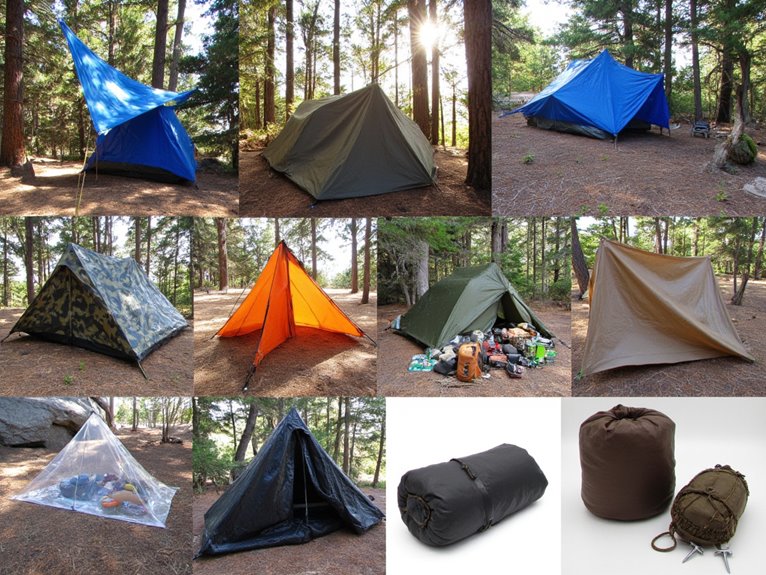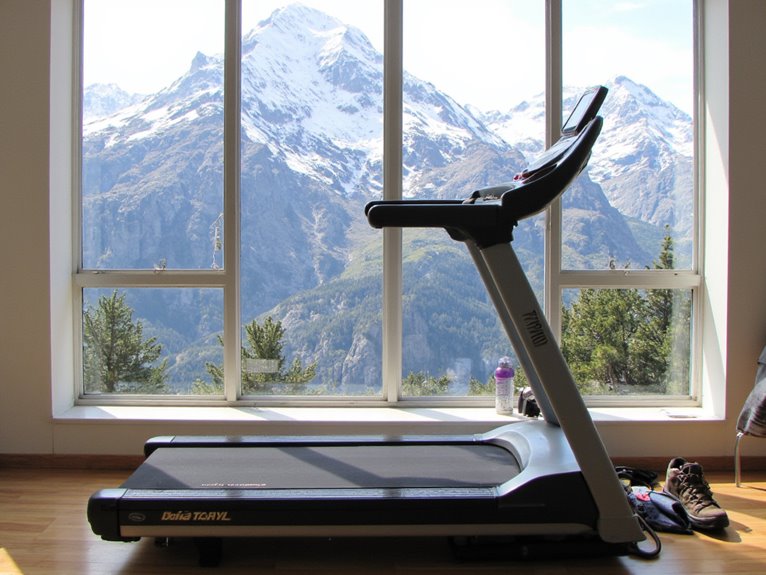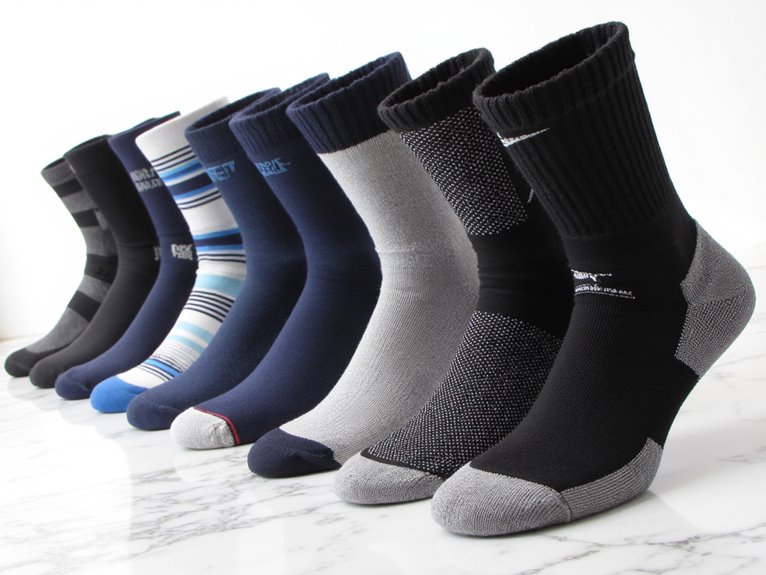Should a Tarp Be Bigger Than a Tent?
A tarp should be bigger than a tent to provide adequate protection from the elements. A general rule of thumb is to add 2-3 feet to the tent's length and width for a waterproof seal. This extra coverage guarantees a comfortable campsite even in unpredictable weather conditions. A larger tarp offers more flexibility to adjust to changing weather conditions and provides peace of mind. However, it's essential to strike a balance between protection and portability. To find your perfect tarp, consider factors like tent size, weather protection, and camping style – and get ready to uncover the ultimate shelter solution that safeguards your outdoor adventure.
We are supported by our audience. When you purchase through links on our site, we may earn an affiliate commission, at no extra cost for you. Learn more. Last update on 18th December 2025 / Images from Amazon Product Advertising API.
Tarp Size and Weather Protection
When selecting a tarp size, it's essential to take into account the unpredictable nature of the weather, as a tarp that's too small can leave your tent and gear exposed to the elements.
A larger tarp provides a wider range of protection, ensuring your campsite stays dry and comfortable.
Consider the type of weather you'll encounter: heavy rain, strong winds, or scorching sun.
A bigger tarp offers more flexibility to adjust to changing conditions, providing peace of mind and a good night's sleep.
Tent Size and Coverage Needs
When it comes to determining the ideal tarp size, it's essential to consider the dimensions of your tent.
A tent's length, width, and peak height all play a crucial role in calculating the necessary tarp coverage area.
Tent Dimensions Matter
Your tent's dimensions are vital in determining the ideal tarp size, as a mismatch can leave you exposed to the elements or struggling with excess fabric.
To ensure a harmonious tent-tarp relationship, consider the following key factors:
A narrow tent requires a tarp with a narrower width to prevent flapping in the wind, while a wider tent benefits from a tarp with more coverage.
Tent height affects tarp size, as a taller tent demands a tarp with more vertical coverage to prevent water from seeping underneath.
Tent shape influences tarp design, with asymmetrical tents requiring a more customized tarp fit.
Tarp Size Considerations
To guarantee adequate coverage, it's vital to examine the tarp's size in relation to your tent's dimensions, taking into account the specific coverage needs of your camping setup.
A general rule of thumb is to add 2-3 feet to the tent's length and width to provide a waterproof seal.
However, this can vary depending on the tent's design and the type of camping you're doing.
For example, if you're car camping, you may want a larger tarp to cover gear and tables, while backpackers may prioritize a smaller, lighter setup.
Coverage Area Needs
One essential aspect of determining the ideal tarp size is understanding the specific coverage needs of your tent, which can vary greatly depending on its size, shape, and camping application.
A larger tent may require a bigger tarp to ensure adequate coverage, while a smaller tent may get by with a smaller tarp.
It's crucial to consider the following factors to determine your coverage needs:
- Will you be camping in an area with heavy rainfall or strong winds, requiring extra protection?
- Do you need to create a vestibule or awning for gear storage or relaxation?
- Are you planning a solo trip or a group adventure, influencing the size of your tent and tarp?
Weighing Tarp Size and Portability
Size matters, but so does portability.
As we weigh our options, it's essential to weigh the sweet spot where tarp size and packability converge.
Tarp Size Considerations
Generally, outdoor enthusiasts find themselves torn between opting for a larger tarp to provide maximum weather protection and selecting a smaller, more portable option to minimize weight and bulk in their backpacks.
In terms of tarp size considerations, it's essential to weigh the pros and cons of each option.
Some key factors to ponder:
- A tarp that's too small may leave you scrambling to find coverage in a sudden downpour,
- A tarp that's too large may become a cumbersome beast in your backpack, making every hike feel like a chore.
- The sweet spot lies somewhere in between, where you can enjoy adequate protection without sacrificing mobility.
Tent Space Allocation
Between the tent's interior space and the tarp's protective coverage, a delicate balance must be struck to guarantee a comfortable and dry camping experience.
When allocating tent space, consider the tarp's footprint and the gear you need to store.
A larger tarp may provide better protection, but it may also encroach on valuable interior space.
Weigh the benefits of a bigger tarp against the need for room to move around and store gear.
A good rule of thumb is to allocate at least 10-15% of the tent's floor space for gear storage and movement.
Larger Tarp for Extra Space
A larger tarp can provide a generous buffer zone around your tent, shielding you from wind-driven rain and snow, while also creating a spacious vestibule for gear storage and relaxation.
This extra space can be a game-changer, especially on longer camping trips or in harsh weather conditions.
Imagine sipping coffee under a dry, tarp-covered patio, while the rain pounds against the fabric above.
Picture a protected area for cooking, where the wind and rain can't interfere with your meal prep.
Envision a cozy, tarp-covered nook for reading or napping, sheltered from the elements.
Wind and Rain Resistance Factors
When choosing a tarp, wind and rain resistance factors are crucial considerations, as even a slight miscalculation can leave you scrambling to reconfigure your setup in the midst of a storm.
A larger tarp may provide more coverage, but it's also more susceptible to wind damage.
Look for tarps with reinforced stitching, sturdy grommets, and a waterproof coating to safeguard your gear stays dry.
Additionally, consider the tarp's wind resistance rating, measured in miles per hour (mph). A higher rating means the tarp can withstand stronger gusts.
Don't get caught off guard – choose a tarp that can withstand the elements, and you'll be singing in the rain, not cursing the storm.
Tarp Material and Durability
Durability hinges on the tarp's material, with options ranging from lightweight silnylon to heavy-duty vinyl, each with its own strengths and weaknesses in the battle against the elements.
When choosing a tarp material, consider the trade-offs between weight, cost, and performance.
Silnylon tarps are whisper-thin and packable, but may not withstand harsh weather.
Polyester tarps offer a happy medium, balancing durability and portability.
Vinyl tarps are the behemoths of the tarp world, providing unparalleled protection, but weighing a small fortune in luggage space.
Camping Style and Priorities
Most campers fall into one of two categories: the minimalist, who seeks to shed every extraneous ounce, and the luxury lover, who prioritizes comfort above all else.
In the realm of tarps and tents, these differing priorities greatly influence the decision of whether a tarp should be bigger than a tent.
The minimalist will likely opt for a smaller, lighter tarp that provides just enough coverage, while the luxury lover will want a spacious tarp to create a comfortable outdoor living space.
Understanding your camping style and priorities is vital in determining the ideal tarp size for your needs.
Group Size and Shelter Needs
The number of campers in your group is a critical factor in determining the ideal tarp size, as it directly impacts the amount of sheltered space needed to guarantee everyone stays dry and comfortable, and to safeguard against the elements.
When planning a group camping trip, consider the following scenarios to determine your tarp size needs:
- A family of four with young kids, requiring ample space for gear and playtime
- A group of friends on a hiking trip, needing protection from the elements during meal prep and relaxation
- A scout troop, requiring a large, communal shelter for team-building activities and bonding
Ultralight Camping Trade-Offs
When stripping down to the bare essentials, ultralight campers must weigh the benefits of a smaller tarp against the risks of exposure, forcing a careful calculation of comfort versus convenience.
The allure of a lighter pack is undeniable, but so is the threat of a soggy night's sleep.
For every ounce shaved off, there's a corresponding loss of protection from the elements.
The ultralight enthusiast must ask: is the weight savings worth the risk of a mid-storm tarp failure?
Perhaps, but only if you're prepared to get creative with some MacGyver-esque tarp-hacking or enjoy a bracing midnight shower.



